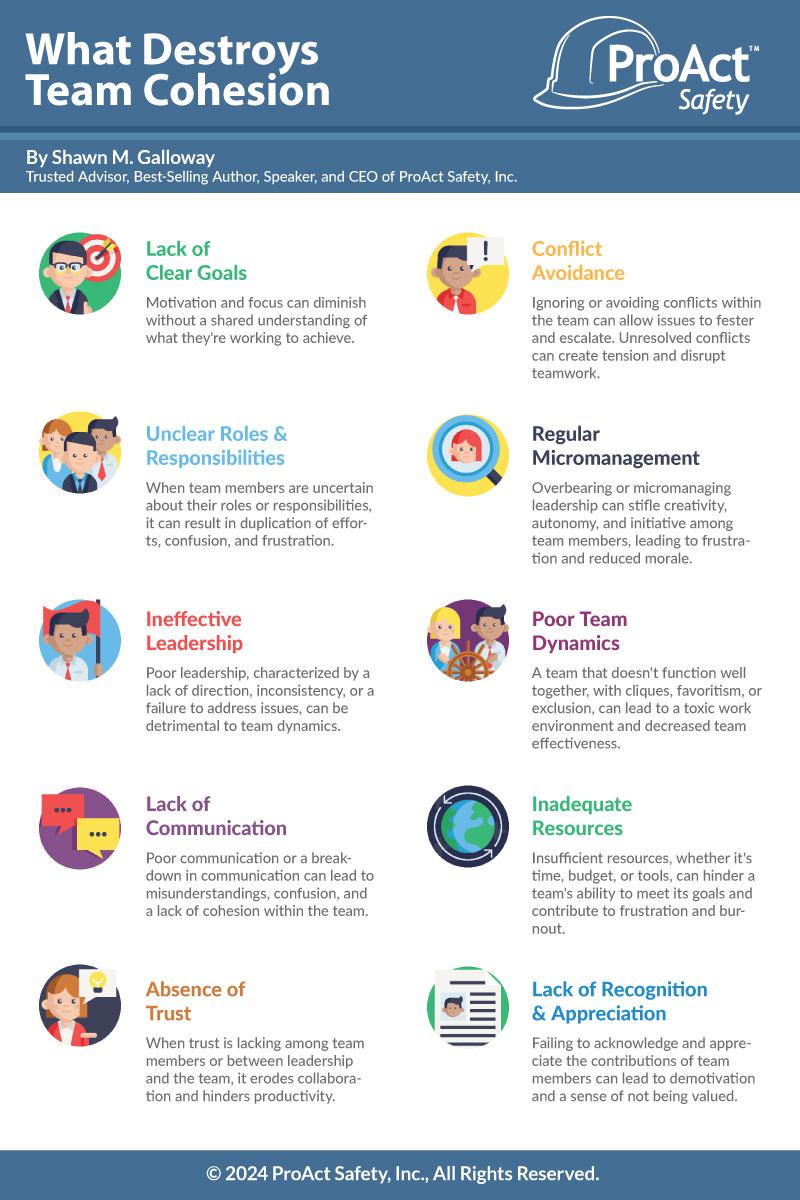May 13 2024
By: Shawn M. Galloway
Team cohesion is essential for fostering collaboration, productivity, and success within any group setting. However, several factors can undermine team cohesion, leading to decreased morale, inefficiency, and poor performance. Let’s explore the key reasons that can destroy team cohesion.
Lack of Clear Goals: When team members lack a shared understanding of the goals they are working to achieve, motivation and focus can diminish. Without clear direction and objectives, individuals may struggle to align their efforts, leading to confusion and disconnection within the team.

Unclear Roles and Responsibilities: Uncertainty about roles and responsibilities can result in duplication of efforts, confusion, and frustration among team members. When individuals are unsure of their contributions and how they fit into the team's overall objectives, it can lead to inefficiency and discord within the group.
Ineffective Leadership: Poor leadership characterized by a lack of direction, inconsistency, or a failure to address issues can be detrimental to team dynamics. Leadership plays a crucial role in guiding and supporting team members, and when leadership is ineffective, it can erode trust, motivation, and cohesion within the team.
Lack of Communication: Effective communication is vital for maintaining cohesion within a team. Poor communication or a breakdown in communication can lead to misunderstandings, confusion, and a lack of alignment among team members. Without clear and open communication channels, collaboration and teamwork suffer.
Absence of Trust: Trust is the foundation of strong team dynamics. When trust is lacking among team members or between leadership and the team, it erodes collaboration and hinders productivity. Building trust requires transparency, honesty, and reliability; without it, team cohesion is significantly compromised.
Conflict Avoidance: Ignoring or avoiding conflicts within the team can allow issues to fester and escalate, leading to tension and disruption of teamwork. Addressing conflicts openly and constructively is essential for resolving differences and maintaining a positive team environment.
Regular Micromanagement: Micromanaging leadership can stifle creativity, autonomy, and initiative among team members. When leaders excessively control or scrutinize every aspect of team members' work, it can lead to frustration, reduced morale, and a lack of trust within the team.
Poor Team Dynamics: A team that does not function well together, with cliques, favoritism, or exclusion, can create a toxic work environment. Poor team dynamics can lead to decreased collaboration, communication breakdowns, and overall reduced effectiveness in achieving team goals.
Inadequate Resources: Insufficient resources, whether in terms of time, budget, or tools, can hinder a team's ability to meet its goals. When team members lack the necessary resources to perform their tasks effectively, it can lead to frustration, burnout, and decreased morale within the team.
Lack of Recognition and Appreciation: Failing to acknowledge and appreciate the contributions of team members can result in demotivation and a sense of not being valued. Recognizing and appreciating team members' efforts and achievements are essential for boosting morale, fostering a positive team environment, and maintaining cohesion.
Team cohesion is critical in achieving success and maintaining a positive work environment. Understanding the factors that can destroy team cohesion, such as a lack of clear goals, ineffective leadership, poor communication, trust issues, conflict avoidance, micromanagement, poor team dynamics, resource constraints, and lack of recognition, is essential for addressing and mitigating these challenges. By proactively addressing these issues and promoting a culture of open communication, trust, collaboration, and appreciation, teams can strengthen their cohesion, enhance their performance, and achieve their goals effectively.
"Building a cohesive leadership team is the first critical step that an organization must take if it is to have the best chance at success." — Patrick Lencioni
"When two forces unite, their efficiency doubles." — Sir Isaac Newton
"No one can whistle a symphony. It takes a whole orchestra to play it." — H.E. Luccock

Shawn Galloway, CEO of ProAct Safety, is an expert in safety excellence. With almost thirty years of experience, he is a highly sought-after advisor, keynote speaker, and expert witness. Shawn has become a trusted partner to leading organizations across various industries worldwide. He ranks in the top 1% of the most prolific writers in his field, having authored over 500 articles and several bestselling books. He also launched the world's first safety podcast, Safety Culture Excellence©. As a recognized authority in safety, Shawn has received awards such as being named among the Top 50 People Who Most Influence EHS and a Top 10 Speaker, among others.
He is a regular guest on Bloomberg, Fox News, The Daily Mail, Dubai One, U.S. News & World Report, Sirius Business Radio, Wharton Business Daily, and leading safety magazines and podcasts. Shawn also serves as a member of the Harvard Business Review Advisory Council, Forbes Business Council, and Fast Company Executive Board, enabling his influence to shape safety thinking and strategy at the executive level.
